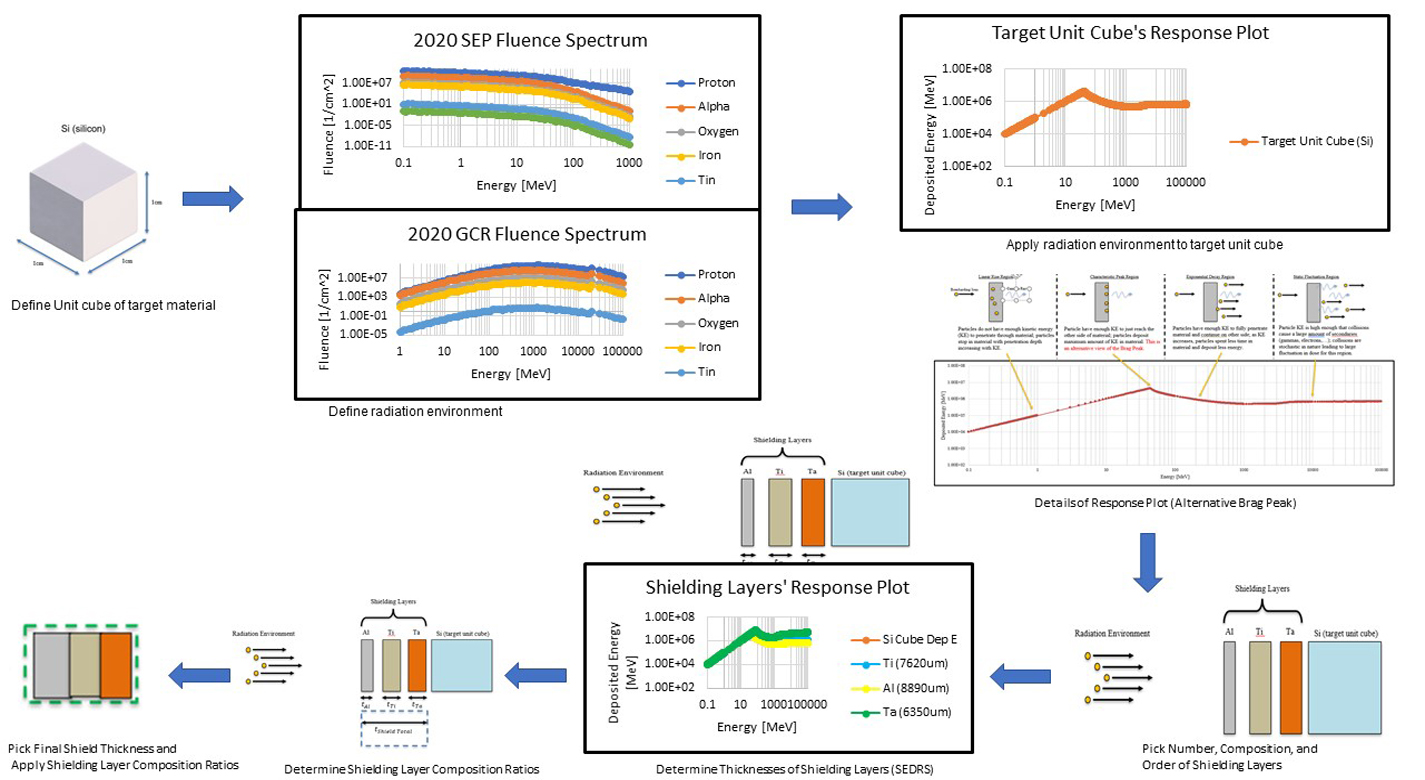Computer-implemented energy depletion radiation shielding
materials and coatings
Computer-implemented energy depletion radiation shielding (TOP2-304)
Stacked Energy Depletion Radiation Shielding (SEDRS) and Layered Energy Depletion Radiation Shielding (LEDRS )
Overview
Radiation shielding for space as well as some terrestrial applications is challenging due to the wide variety and energy ranges of radiation particles. Thin layers of material or shielding, or both, placed between the radiation environment and a target, sensitive electronics or biology, has some effect on mitigating radiation dose or damage caused by radiation in a material. Another issue with common radiation shielding designs is that a single shielding material will respond differently to different types or energies of radiation or might produce secondary radiation that can be just as damaging as the primary radiation. NASA Ames has developed a novel technology that provides a new process for designing and accurately tuning radiation shields to possess the specific characteristics required for each application before testing, reducing the need for iterative radiation beam testing throughout the development process.
The Technology
The difference between Layered Energy Depletion Radiation Shielding (LEDRS) and Stacked Energy Depletion Radiation Shielding (SEDRS) is how the piece of matter, or shield, is analyzed as radiation passes through the matter.
SEDRS involves using a defined and ordered stack of layers of shielding with different material properties such that the thickness and chemical properties of each material maximizes the absorption of energy from the radiation particles that are most damaging to the target. The SEDRS shielding method aims to provide the maximum level of energy absorption while still keeping shielding mass and volume low.
The process of LEDRS involves using layers of shielding material such that the thickness of each material is designed to absorb the maximum amount of energy from the radiation particles that are most damaging to the target after subsequent layers of shielding. The more energy is absorbed by the shielding material, the less energy will be deposited in the target minimizing the required mass to achieve a resulting lower dose for a given geometrical feature. The LEDRS shielding method aims to provide the maximum level of energy absorption. The process for designing LEDRS views potential radiation shields as a cascade of effects from each shielding layer to the next and is helpful for investigating the particular effects of each layer.
SEDRS and LEDRS can improve any technology that relies on the controlled manipulation of a radiation field by interaction with a material element.


Benefits
- Efficient design of radiation shields tailored for specific radiation environments; analyzing the potential properties of different shielding combinations aids in reductions in the cost and time to design the shielding
- For electronics, better shielding allows for more advanced, less radiation-hardened circuits to be used without failure
- SEDRS and LEDRS method can be applied iteratively in conjunction with practical manufacturing constraints to develop the best possible shielding material for a given application
- Stacking shielding layers so that each layer's response peak is to the right (at a higher energy level) of the target material's response peak ensures that the most detrimental radiation is blocked by the shielding
- Adjusting each shielding layer's response to match the shifted radiation environment resulting from the initial radiation environment passing through previous shielding layers
- Developing normalized shielding layer ratios for a given composition of shielding materials that provide the thinnest possible shielding layer with maximum amount of energy absorption
- SEDRS and LEDRS can improve any technology that relies on the controlled manipulation of a radiation field by interaction with a material element
Applications
- Space Industry for improving radiation shielding for manned missions to the Moon or Mars, or providing enhanced radiation capabilities to satellites in LEO
- Medical industry for improving medical radiation therapy by enabling the optimization of radiation-lensing systems to emit only the desired radiation, as well the optimization of lens materials for reduced cost. Such lensing systems may be employed for MRI, CT, and radiation therapy devices, among others
- Ion propulsion applications for providing tailored radiation lensing to create the radiation streams with the desired characteristics
- Energy industry for providing shielding as in the space industry, or for assisting in the development of new energy methods by enabling specific, controlled reactions
- The integrated circuit industry for developing radiation-tolerant packaging
- Department of Defense for protecting of soldiers from radiation hazards
- Department of Energy for using in nuclear defense labs
- Sensor instruments for using with controlled beams of radiation in X-rays, CAT Scans, and a variety of other sensors to induce reactions from a target that can be measured and analyzed
- Commercial and military aircraft for providing improved radiation shielding
Technology Details
materials and coatings
TOP2-304
ARC-18488-1
|
Tags:
|
Similar Results

Atomic Number (Z)-Grade Radiation Shields from Fiber Metal Laminates
This technology is a flexible, lighter weight radiation shield made from hybrid carbon/metal fabric and based on the Z-grading method of layering metal materials of differing atomic numbers to provide radiation protection for protons, electrons, and x-rays. To create this material, a high density metal is plasma spray-coated to carbon fiber. Another metal with less density is then plasma spray-coated, followed by another, and so on, until the material with the appropriate shielding properties is formed. Resins can be added to the material to provide structural adhesion, reducing the need for mechanical bonding. This material is amenable to molding and could be used to build custom radiation shielding to protect cabling and electronics in situations where traditional metal shielding is difficult to place.

Novel Radiation Shielding Material for Dramatically Extending the Orbit Life of Cubesats
A high density metal, such as tantalum or tungsten is coated onto thin aluminum sheet in precise ratios and thicknesses. The combined sheet is then easily formed into standardized enclosures compatible with CubeSat design and performance specifications.

High Atomic Number Coatings for Fabrics
High atomic number materials, such as tantalum, do not bond well to oxygen- and hydroxyl-rich surfaces, such as glass fibers. These metals often form surface oxides when layered on glass fabric, resulting in flaking of the high atomic number material off the fabric during cutting, folding, and/or handling.
To improve coating durability, this invention applies a lower atomic number metal as a tie down layer first before applying the high atomic number metal layer. The tie down layer reduces oxide formation between the substrate and the high atomic number material, promoting adhesion. Titanium has shown strong adhesion with different metals and is effective at reducing oxide formation when diffusion bonded to itself or other materials. It has been shown to be effective at improving durability when thermally sprayed onto a glass fiber fabric as a tie down layer for a subsequent tantalum layer (also applied via RF plasma spray). The titanium layer is only approximately 1 mil thick but results in strong adhesion of the tantalum layer by inter-metallic or diffusion bonding. A thermal spray process may be used, as well.
This innovation enables the delivery of high atomic metal coating on glass fiber fabrics and other polymeric substrates that are lower cost, lighter weight, and durable to form a flexible cloth material with Z-graded radiation shielding. Coated samples have been produced and the technology is currently at a technology readiness level (TRL) of 4 (prototype).

Flexible Lightweight Radiation Shielding
The thin, lightweight radiation shielding is comprised of a low Z/high Z/low Z layered structure wherein the low Z layer is composed of titanium and the high Z layer is composed of either tantalum or antimony. Modelling of radiation shielding performance from a Cobalt 57 source shows a 10 times reduction in gamma radiation when using tantalum and a 25 times reduction when using antimony as compared with a single layer of lead. In addition, the Z-shielding is 25% lighter than a single lead layer with the same thickness (0.35-0.36 mm). The direct textile spraying innovation outlined by this invention enables the ability to shape this shielding into garments via the sewing of metal coated fibers. The refractory metal shielding can be added onto a variety of commodity-based fabrics including glass fabrics.

Biologically-Inspired Radiation-Reflecting Ablator
Reentry heating comes from two primary sources: Convective heating from both the flow of hot gas past the surface of the vehicle and catalytic chemical recombination reactions at the surface; and Radiation heating from the energetic shock layer in front of the vehicle. The magnitude of stagnation heating is dependent on a variety of parameters, including reentry speed, vehicle effective radius, and atmospheric density. As reentry speed increases, both convective and radiation heating increase. At high speeds, radiation heating can quickly dominate and as the effective vehicle radius increases, convective heating decreases, but radiation heating increases. Radiation during reentry is a function of reentry speed which occurs very early in reentry for very specific wave-lengths and is dependent upon atmospheric composition. The Biologically-Inspired Radiation-Reflecting Ablator (BIRRA) approach converts amorphous silica of diatoms to a more refractory material, Silicon carbide (SiC), and incorporates it into a Thermal Protection System (TPS), especially near the surface to provide enhanced reflection during the initial stage of reentry into planetary atmospheres at high speeds. Different diatom species reflect different wavelengths. This conversion is performed in a fluidized bed reactor or other type of reactor to convert naturally ordered structures to higher temperature materials with a photonic structure that can better reflect radiation. TPS that shields vehicles from both radiative and convective heat would allow reduction of the mass fraction of the TPS, which will increase the mass fraction available for payload or reduce the overall mass and thus launch and propulsion requirements.



